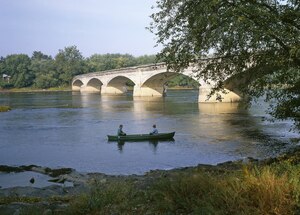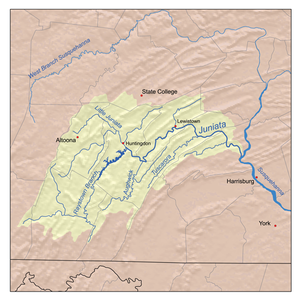Juniata River
| Juniata River | |
|---|---|
 The Appalachian Trail crossing the mouth of the Juniata River. Photo by Carol M. Highsmith | |
 Juniata River watershed and tributaries | |
| Location | |
| Country | United States |
| State | Pennsylvania |
| Counties | Dauphin, Perry, Juniata, Mifflin, Huntingdon, Bedford, Somerset |
| Cities | Duncannon, Newport, Millerstown, Thompsontown, Port Royal, Mifflintown, Lewistown, Mount Union, Huntingdon |
| Physical characteristics | |
| Source | Frankstown Branch |
| • location | Blair County, Pennsylvania, US |
| 2nd source | Little Juniata River |
| • location | Pennsylvania, US |
| Source confluence | |
| • location | Petersburg, Pennsylvania, US |
| • coordinates | 40°33′39″N 78°04′06″W / 40.56083°N 78.06833°W |
| • elevation | 660 ft (200 m) |
| Mouth | Susquehanna River |
• location | Duncannon, Perry County, Dauphin County, Pennsylvania, US |
• coordinates | 40°24′05″N 77°00′48″W / 40.40139°N 77.01333°W |
• elevation | 330 ft (100 m) |
| Length | 104 mi (167 km) |
| Basin size | 3,400 sq mi (8,800 km2) |
| Discharge | |
| • location | Newport |
| • average | 4,476 cu ft/s (126.7 m3/s) |
| • minimum | 636 cu ft/s (18.0 m3/s) |
| • maximum | 209,000 cu ft/s (5,900 m3/s) |
| Discharge | |
| • location | Mapleton Depot |
| • average | 2,724 cu ft/s (77.1 m3/s) |
| Basin features | |
| Tributaries | |
| • left | Tuscarora Creek |
The Juniata River (/ˈdʒuːniˌɑːtə/) (pronounced joo-nee-ah-tah [1]) is a tributary of the Susquehanna River, approximately 104 miles (167 km) long,[2] in central Pennsylvania. The river is considered scenic along much of its route, having a broad and shallow course passing through several mountain ridges and steeply lined water gaps. It formed an early 18th-century frontier region in Pennsylvania and was the site of French-allied Native American attacks against English colonial settlements during the French and Indian War.
The watershed of the river encompasses an area of approximately 3,400 square miles (8,800 km2), approximately one-eighth of the drainage area of the Susquehanna. Approximately two-thirds of the watershed is forested. It is the second largest tributary of the Susquehanna after the West Branch Susquehanna.
Description
The Juniata River forms in western
Along the river's banks there are many access areas maintained by the Pennsylvania Fish and Boat Commission, as well as informal access areas and campground river access. The Juniata River is a popular spot for swimming, fishing, and boating. It even used to be the host of the Juniata River Sojourn,[5] which was held annually from 2001 (when the river was named Pennsylvania River of the Year[6]) through 2015.
Etymology
The word "Juniata" is thought to be a corruption of the
History
The first known inhabitants of the river valley were the
During the 19th century, the river was paralleled by the Juniata Division Canal, part of the canal system of Pennsylvania and a rival to the Erie Canal. The state sold the canal to the Pennsylvania Railroad, which abandoned the canal in 1889 after severe flooding. Parts of the original locks from the canal, as well as remnants of a dam approximately 1 mile (2 km) south of Millerstown, are still visible today.
The river is a popular destination for recreational canoeing and fly fishing, in particular for smallmouth bass and channel catfish suited to the river's gentle course. The muskellunge was introduced as predatory sport fish and is now a prized catch. Attempts are underway by the state to reintroduce the once-prevalent American shad, which went into decline largely because of dams on the river. Walleye is another game fish prevalent in the Juniata River.
The National Book Award and Pulitzer prize-winning poet Galway Kinnell wrote of the river in a section of The Book of Nightmares (1971), entitled "Dear Stranger, Extant in Memory by the Blue Juniata" ("The Blue Juniata" was a well-known 19th-century parlor song).
The river cuts through several southwest-to-northeast ridges, largely of sandstone between limestone valley floors. Several of the river's tributaries, including Kishacoquillas Creek, are degraded by pollution, but the main stem of the river is considered fairly clean by regional standards. The only city in the watershed with ten thousand or more residents is Altoona. Steep slopes along much of the river's course have largely discouraged widespread development.
Gallery
-
Panoramic view of the Juniata River. Taken in the summer of 2006, a couple of miles downstream from Riddlesburg, PA.
-
The Juniata River by Lewistown, Pennsylvania
References in Culture
Sharon Green wrote the dance "Juniata". in 2011 and Jonathan Jensen wrote the tune Drifting on the Dreamy Juniata.
Sebastian Junger writes about the Juniata River and the surrounding region in his 2021 book Freedom.
See also
References
- ^ "Juniata College - All Together Now: JOO-NEE-AT-UH!". Retrieved 2023-12-23.
- ^ U.S. Geological Survey. National Hydrography Dataset high-resolution flowline data. The National Map Archived 2012-03-29 at the Wayback Machine, accessed August 8, 2011
- ^ U.S. Geological Survey Geographic Names Information System: Juniata River
- ^ "Juniata River". Natural Atlas. Retrieved 2021-10-08.
- ^ raystownmatt (2013-04-23). "Main Stem Madness: A Day on the Juniata River Sojourn". Raystown Moments. Retrieved 2021-10-08.
- ^ "PA River of the Year".
- ^ Kaylor, 103
Bibliography
- Kaylor, Earl C. 1996. Martin Grove Brumbaugh: A Pennsylvanian's Odyssey from Sainted Schoolman to Bedeviled World War I Governor, 1862–1930. Fairleigh Dickinson University Press.
- McIlnay, Dennis P. 2003. Juniata, river of sorrows: One Man's Journey Into a River's Tragic Past. Seven Oaks Press.
External links
- U.S. Geological Survey: PA stream gaging stations
- Juniata Clean Water Partnership
- "The Juniata and Chesapeake Bay" (PDF). Archived from the original (PDF) on 2004-08-06. Retrieved 2004-05-11. (16.7 KB)







